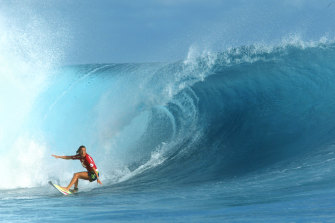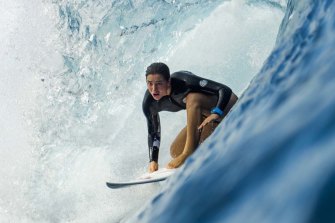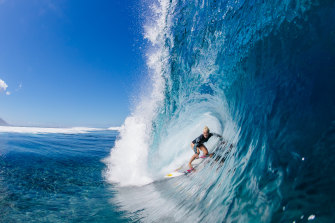Seven-time world champion Layne Beachley stood with US surfer Keala Kennelly after an epic showdown at Teahupo’o, Tahiti, home to one of the most iconic and dangerous waves in the world.
Beachley had lost to Kennelly in the 2002 final. Both women were conducting interviews afterwards. The Australian champion noticed pools of blood on the ground. Her feet, arms, legs and back had been slashed by the razor-sharp reef. The break exacted a similar toll on Kennelly. The two warrior queens laughed at each other.
“We hosed each other down with champagne because we were both covered in blood,” Beachley says.

Layne Beachley at the Billabong Pro Teahupo’o in 2002 before hitting the coral reef.Credit:Grant Ellis
Four years later the then Association of Surfing Professionals [which became the World Surf league in 2015] stopped holding women’s contests at Teahupo’o, citing safety concerns — while continuing to let men compete.
Beachley seethed, calling it sexist. It became a rallying point among women surfers over their treatment generally and equality of access to good waves and prizemoney specifically.
Fast forward 14 years, on Friday night (Australian time), the World Surf League made a significant announcement towards healing this rift.
Its 2020 season was over, brought down by the coronavirus pandemic.
Instead, a new tour will start in Hawaii for the 2020-21 season. The 10-event format will culminate in the top five men and women competing in a single-day surf-off to decide the world champion.
Plus, there was another piece of information buried in the schedule: Teahupo’o was back … for women.
League vice president Jessi Miley-Dyer said the organisation had made “huge strides” to put the best surfers on the world’s best waves. Last year the WSL committed to offering equal prizemoney for men and women.
It also follows a move by the organisers of the Paris Olympics in 2024 to hold their surfing events for men and women in Tahiti.
“This decision [Teahupo’o] represents a pivotal moment for surfing that sees the women returned to waves of consequences,” Miley-Dyer says.
Teahupo’o is a wave of extreme consequence, a literal killer. Five surfers have lost their lives since the mid-1980s.
Roughly translated, Teahupo’o means “wall of skulls”, “the pile of heads” or “to sever the head”.
It’s the ocean’s equivalent of trying to sprint across a vertical wall of a giant, crumbling building rigged with explosives for implosion.
At take-off, surfers are almost freefalling down the front of the wave before finding their line to enter a truly cavernous yet lethal barrell. Unlike many other waves, the barrell sinks into a deeper pit of hell or ecstasy, meaning the exit point often disappears from view, and sometimes even curves around.
After surfers exit upwards, or more accurately are spat out, cameras in nearby boats frame their visage in a melting moment of stunned relief, survivor’s guilt and religious epiphany.

Tyler Wright says surfing Teahupo’o demands respect. She has only surfed it once for a Rip Curl promotional video in 2015.Credit:Rip Curl / Corey Wilson
Two-time world champion Tyler Wright has surfed Teahupo’o once. It scared her. It was intense. It was dangerous. But she wants to surf it again next year.
The Gold-Coast based surfer wants to study its ways and vagaries, develop the knowledge and conditioning to work with it.
She says competition organisers must avoid turning the event into one judging the worthiness of women to compete in Tahiti.
“There will be some trying to frame the issue that way, that girls should be able to go out there and perform straight away,” Wright says. “But it has to be framed in a way that it took the men however many years to get to where they are today. And I think it will take a similar amount of time for women.
“But I’m always on the more cautious side. I’m in the later stages of my career, but I could imagine being 17 or 18 and thinking this is the greatest opportunity that anyone could have given me to push myself to excel.”
Loading
Replay
Beachley says the Teahupo’o recall is another step towards breaking down the chauvinism in surfing and that the sport has taken extraordinary steps recently to celebrate the “power, and style and grace and beauty” of women surfing.
Teahupo’o, Beachley says, made her a better athlete. And it can do the same again for a new generation.
“It was a place that really taught me how to stand up in the face of fear and embrace the fear and overcome the fear,” she says.
“All I can say is hallelujah. The women are back.”

Tatiana Weston-Webb enjoys surfing at the Wall of Skulls before the start of the men-only 2019 Tahiti Pro Teahupo’o. Credit: Matt Dunbar/WSL via Getty Images
Get our Morning & Evening Edition newsletters
The most important news, analysis and insights delivered to your inbox at the start and end of each day. Sign up to The Sydney Morning Herald’s newsletter here, to The Age’s newsletter here and Brisbane Times‘ here.





Recent Comments